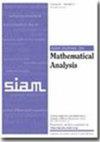Lipschitz Optimal Transport Metric for a Wave System Modeling Nematic Liquid Crystals
IF 1.9
2区 数学
Q1 MATHEMATICS, APPLIED
引用次数: 0
Abstract
SIAM Journal on Mathematical Analysis, Volume 56, Issue 4, Page 5144-5174, August 2024.Abstract. In this paper, we study the Lipschitz continuous dependence of conservative Hölder continuous weak solutions to a variational wave system derived from a model for nematic liquid crystals. Since the solution of this system generally forms a finite time cusp singularity, the solution flow is not Lipschitz continuous under the Sobolev metric used in the existence and uniqueness theory. We establish a Finsler type optimal transport metric, and show the Lipschitz continuous dependence of the solution on the initial data under this metric. This kind of Finsler type optimal transport metrics was first established in [A. Bressan and G. Chen, Arch. Ration. Mech. Anal., 226 (2017), pp. 1303-1343] for the scalar variational wave equation. This equation can be used to describe the unit direction [math] of mean orientation of nematic liquid crystals, when [math] is restricted on a circle. The model considered in this paper describes the propagation of [math] without this restriction, i.e. [math], takes any value on the unit sphere. So we need to consider a wave system instead of a scalar equation.
建模向列液晶的波系统的 Lipschitz 最佳传输度量
SIAM 数学分析期刊》,第 56 卷第 4 期,第 5144-5174 页,2024 年 8 月。 摘要本文研究了由向列液晶模型导出的变分波系统的保守霍尔德连续弱解的 Lipschitz 连续依赖性。由于该系统的解一般会形成一个有限时间的尖顶奇点,因此解流在存在性和唯一性理论中使用的 Sobolev 度量下不是 Lipschitz 连续的。我们建立了一种 Finsler 型最优传输度量,并证明了在此度量下解对初始数据的 Lipschitz 连续依赖性。Bressan and G. Chen, Arch.Ration.Mech.Anal., 226 (2017), pp. 1303-1343]中首次建立了标量变分波方程。当[math]被限制在一个圆上时,该方程可用于描述向列液晶平均取向的单位方向[math]。本文所考虑的模型描述的是没有这种限制的[math]传播,即[math]在单位球面上取任意值。因此,我们需要考虑一个波系,而不是标量方程。
本文章由计算机程序翻译,如有差异,请以英文原文为准。
求助全文
约1分钟内获得全文
求助全文
来源期刊
CiteScore
3.30
自引率
5.00%
发文量
175
审稿时长
12 months
期刊介绍:
SIAM Journal on Mathematical Analysis (SIMA) features research articles of the highest quality employing innovative analytical techniques to treat problems in the natural sciences. Every paper has content that is primarily analytical and that employs mathematical methods in such areas as partial differential equations, the calculus of variations, functional analysis, approximation theory, harmonic or wavelet analysis, or dynamical systems. Additionally, every paper relates to a model for natural phenomena in such areas as fluid mechanics, materials science, quantum mechanics, biology, mathematical physics, or to the computational analysis of such phenomena.
Submission of a manuscript to a SIAM journal is representation by the author that the manuscript has not been published or submitted simultaneously for publication elsewhere.
Typical papers for SIMA do not exceed 35 journal pages. Substantial deviations from this page limit require that the referees, editor, and editor-in-chief be convinced that the increased length is both required by the subject matter and justified by the quality of the paper.

 求助内容:
求助内容: 应助结果提醒方式:
应助结果提醒方式:


